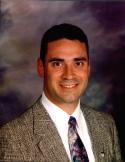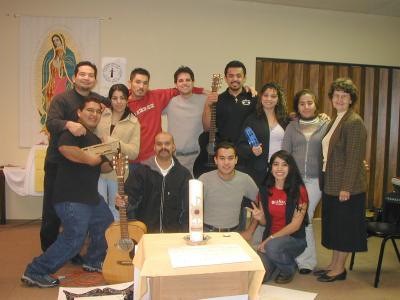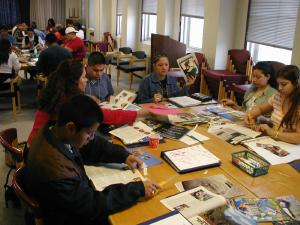Issue Date: January 30, 2004
Catholic church must meet challenges of ministry to Hispanic youth, report says, or 'risk losing a significant portion of the faithful for generations to come' By JEFF GUNTZEL The 2000 census confirmed all the hunches: The Hispanic population in the United States is soaring. The numbers are eye-opening: A 58 percent increase in the overall Hispanic population since 1990. Hispanic young people ages 15 to 29 grew by 54 percent. And Hispanic children ages 0 to 14 grew by 62 percent. Hispanics will soon be this country’s largest minority group. By some counts, they already are. Everyone has taken notice, politicians, TV networks and certainly the Catholic church. It is a rare church meeting or convention that does not in some way recognize the growing demographic reality. There’s a big difference, however, between noticing the changes and knowing what to do about them. A recent report, “The Status of Hispanic Youth and Young Adult Ministry In the United States,” published by Instituto Fe Y Vida, assesses not only how the Catholic church in the United States is facing the challenges and opportunities presented by such a dramatic shift, but also how much is at stake. “The Catholic church must come to terms with the challenge of ministering to its Hispanic population,” the report warns, “or it may risk losing a significant portion of the faithful for generations to come.” The institute, source of the earlier statistics on Hispanics, is an organization focused on evangelization, formation and leadership among Hispanic youth and young adults. It estimates that Hispanics now account for more than 45 percent of all Catholics under the age of 30 in the United States. And that number, by most accounts, is climbing. So it would seem an easy assumption to some that the church would be shifting significant resources to the new population. But that is not often the case, according to the report and interviews with workers in the field who are left to battle for funds and against assumptions of some who lead the church. One of the 10 largest Joe Castro didn’t need a census to understand the challenges posed by the new demographics. He is the Spanish program director at the Christian Renewal Center, a retreat center in Dickinson, Texas, run by the Missionary Oblates of Mary Immaculate. Castro works with Hispanic young adults from the parishes of the Galveston-Houston diocese. “What we have accomplished here,” said Castro, “hasn’t been without a struggle and we are still struggling.” The Galveston-Houston diocese has one of the 10 largest Hispanic populations in the country. And in 2000, according to the report by Instituto Fe Y Vida, as many as 70 to 75 percent of Catholics under the age of 30 in the diocese were Hispanic. “But if you go out in the diocese,” said Castro, “and you see who has been contracted to work in the parishes, you’ll find that the only youth ministers out there are working almost exclusively with English-speaking Anglos.” And if you look at diocesan spending, he continued, “the majority of the resources -- both financial and manpower -- are going to the English and not to the Spanish programs.” Instituto Fe Y Vida calls this phenomenon “structural exclusion.” And the problem is widespread, according to the report recently published by the institute.
“There seems to be a myth among Catholic youth ministers that Hispanic teens will be cared for by the Hispanic adults who are of their culture, so the non-Hispanic ministers need not reach out to them,” the report’s author, Ken Johnson-Mondragón, wrote in an article summarizing the document’s more than 100 pages. “The reality,” the report continues, “is that most Hispanic youth are living between two cultures, neither of which is fully theirs. This means that adult leaders of youth ministry -- both Hispanics and non-Hispanics alike -- must learn to do cross-cultural ministry in order to reach more of today’s Hispanic youth.” Castro has taken this message to diocesan meetings. But progress -- and there has been progress -- is slow. “It’s a constant struggle,” Castro said, “to make them aware and also to make them respond.” Respect for differences “There is this notion that we ought to be one,” he added. “We should be one, but we need to respect the languages and the culture and see what best works with this group of people without forcing something on them.” Bill Cork directs the Office of Young Adult and Campus Ministry for the Galveston-Houston diocese. Cork and Castro have been working together to connect with the area’s Hispanic Catholic youth and young adults for more than five years. When Cork came on board with the diocese he counted about three-dozen Anglo young adult groups scattered throughout the parishes. Hispanic young adult groups were equal in number. The diocese was working with the young Anglo groups. The Hispanic groups were on their own.
“It was like two parallel realities,” Cork said. “I’ve gone to a lot of workshops and conferences and I’ve read a lot of books. The resources on young adult ministry are targeting the Anglo yuppie segment. They just don’t relate to the reality in Galveston-Houston.” But according to Johnson-Mondragón, the problem of relating to Hispanic Catholic youth and young adults goes deeper than conferences and books. According to the Fe Y Vida report, Hispanics account for more than 45 percent of all Catholics under the age of 30 in the United States. But that percentage -- big and getting bigger -- is not reflected in church leadership. “Most dioceses now have a diocesan director of youth ministry,” Johnson-Mondragón explained. “Probably less than half of these directors have a coordinator of pastoral juvenil hispana, which is the Spanish counterpart and focuses on Spanish-speaking immigrant young adults.” In addition, he said, “Only 5 percent or less of the diocesan directors are themselves Hispanic. That’s not necessarily a problem in itself, ... they receive very little training in the area of cross-cultural ministry.” Challenges and gifts Looking at the “challenges and gifts” Hispanic youth and young
adults bring to the church, the Fe Y Vida report identified four categories:
“immigrant worker,” “identity seeker,” “mainstream
mover,” and “gang members and youth at risk.” ( Still, the report cautions, most youth and young people “will not fit neatly into any one category.” In general, Johnson-Mondragón said, Hispanic youth and young adults “tend to feel intimidated or alienated from the mainstream youth ministry.” “Not necessarily by intentional effort of the youth ministers,” he said, “but just by the nature of race relations in the United States today at the level of teenagers. You know, they don’t interact very well at school, they don’t interact very well in the neighborhoods, and all of a sudden you expect them to come to the parish and all of that is just going to disappear. Well it doesn’t. “So how do you overcome that in a constructive way for the parish and for the youth?” Johnson-Mondragón is humble about the challenges the church faces. “We’re telling people there is a problem,” he said, “but we don’t necessarily have the solution.” But the solutions are out there. They just need to be found. In Galveston-Houston -- with the blessing of the diocese but not its funding -- Castro launched Prophets of Hope, a diocese-wide Hispanic leadership formation program. For half a decade Castro, under the auspices of the Christian Renewal Center, has hosted retreats and formation workshops with Hispanic youth and young adults at the basic, intermediate and advanced levels. The first intermediate graduating class formed something called Pastoral de Conjunto, which, according to Castro, translates loosely to Collaborative Action Committee. Castro is an adviser to the group, which works tirelessly to connect Hispanic youth throughout the diocese. And he is proud of them. So is Bill Cork, whose office now provides scholarships for Hispanic young adults in the diocese to attend the trainings that gave rise to the group. Not professionals Still, Castro said, “we have a young adult volunteer group that heads up all of the work that is done with Hispanics here.” “Volunteers, not professionals,” he emphasized. “Big hearts, but still not professionals.” There is frustration. And Cork understands. “There is so much that they would like -- and sometimes it seems like the steps that we’re taking to respond are baby steps. We aren’t able to respond to things as quickly as they can. But that’s the nature of a bureaucracy. If things are going to happen and if they’re going to happen quickly -- they’re going to happen through volunteers. “What we have in young adult ministry in our diocese,” he added, “is not due so much to diocesan vision or forethought, but the fact that some key individuals in ministry -- both volunteers and some of our priests -- have seen the need and have been working.”
In other places, it is not all dependent on bottom-up initiatives. It was a little more than a year ago that the Boise diocese -- which encompasses the entire state of Idaho -- hired Laura Henning as the coordinator of youth ministry for the diocese. This is her second year on the job. From the beginning, she has asked important questions. When she took the job, she said, “there was no one really paying attention” to the young Hispanic population in the diocese. “At the same time,” she said, “the director of our office was doing a study with the census and other info.” So she looked at the numbers. She was shocked to find that “about 40 to 45 percent” of the youth and young adults in the diocese were Hispanic. With the new information, Henning and the diocese got right to work. “The only source of funding at that point was not in the form of programming but mainly in the form of scholarships for various events. “So we asked to reallocate some of the funds. We asked for a substantial amount” The office hired a part-time leader to help. In fact, Henning said, spending on programs working with Hispanic youth has at least doubled since she came on board. Henning and the diocese had good reason to move fast. Many Hispanic Catholics, she said, “are leaving to go to other faiths for lack of service. “So we asked ourselves, how many Masses we have in Spanish? What do we need to do better? “We’ve been realigning pastors,” she continued. “The rector of the cathedral is now a Colombian priest and they’ve started a Spanish Mass. We also brought in Instituto Fe Y Vida to do an exploratory workshop to help us understand the reality of Hispanic young people. “And we’re beginning to work on the grassroots level to build up leadership. We identified leaders in the different parishes and began training them on various levels through the Fe Y Vida program. And our goal in the next year is to hire somebody on the educational staff that would work specifically with the Hispanic population. “The biggest thing,” Henning said, “is the lack of leadership. We’re really looking at that specific segment of it. How can they partner with us as leaders in everything we do? It’s not, ‘We’re going to help these people,’ but ‘How can they help us figure out what we’re going to do?’ So we’re looking at it as more of a cooperative partnership. We’ve put together a pastoral planning team for Hispanic ministry with representative leaders from the different areas to look at the future and how we’re going to build and grow the ministry.” But what about the national church leadership? On the radar screen Barbara Anderson is the Program Coordinator for the Secretariat for Family, Laity, Women and Youth at the U.S. Conference of Catholic Bishops. Anderson says the issues surrounding the church’s challenge in reaching out to Hispanic youth and young adults are on their radar screen.
In concert with the Bishops’ Committee on Hispanic Affairs, the Secretariat for Family, Laity, Women and Youth has adopted an initiative to address the needs of Hispanic youth. One of the tasks outlined in the initiative, says Anderson, is promoting the collaboration between Hispanic ministry offices and youth and young adult ministry offices within the various dioceses. And definitely to reach out both in English and Spanish with any kinds of materials that we produce. Of course, there are bound to be obstacles. Among those, said Anderson, is recognizing cultural differences. “There really is a very different perspective in terms of family and youth between the Hispanic culture and what I guess we would term the American culture. “We must realize that not every program we offer to the Hispanic community will automatically translate just because we put it in Spanish. We sometimes have to adapt things that we’ve always done in the mainstream to make sure that the Hispanic community feels welcomed and is comfortable with the activities or the materials that are being provided.” Asked if national efforts such as the initiative Anderson described had sent any ripples to Boise, Hennings answered, “Documents, yes, reality, no.” But Fe Y Vida and a cadre of organizations working with Hispanic Catholic youth want to change that. Finding the best practices There is talk of a symposium that would gather people in parish and diocesan ministry from all over the country who are doing good work. The end result, Johnson-Mondragón said, would be to “get the best practices -- what works and what doesn’t -- and begin to document and distribute it. We can put tools in the hands of people who need to use them.” At the end of January, the bishops’ committee will decide whether to fund the effort. “Hopefully we’re going to get money from the bishops to do the symposium this summer,” Johnson-Mondragón said. “It’s a real sign of hope that it’s in the works. It’s very much what is needed at this time. Once the tools are available,” he added, “it’s just a matter of motivating people to use them. There will be resistance, but that’s part of the slowness of institutional change.” “We’re doing ministry too often in too many places based on a demographic model of 20 years ago,” Bill Cork said. “This isn’t an issue that is going to go away. It’s the future of the church. This is something that is going to be sweeping across the rest of the country,” he added. “And the church has to respond.” Jeff Guntzel is a freelance writer living in Indianapolis. National Catholic Reporter, January 30, 2004 |




